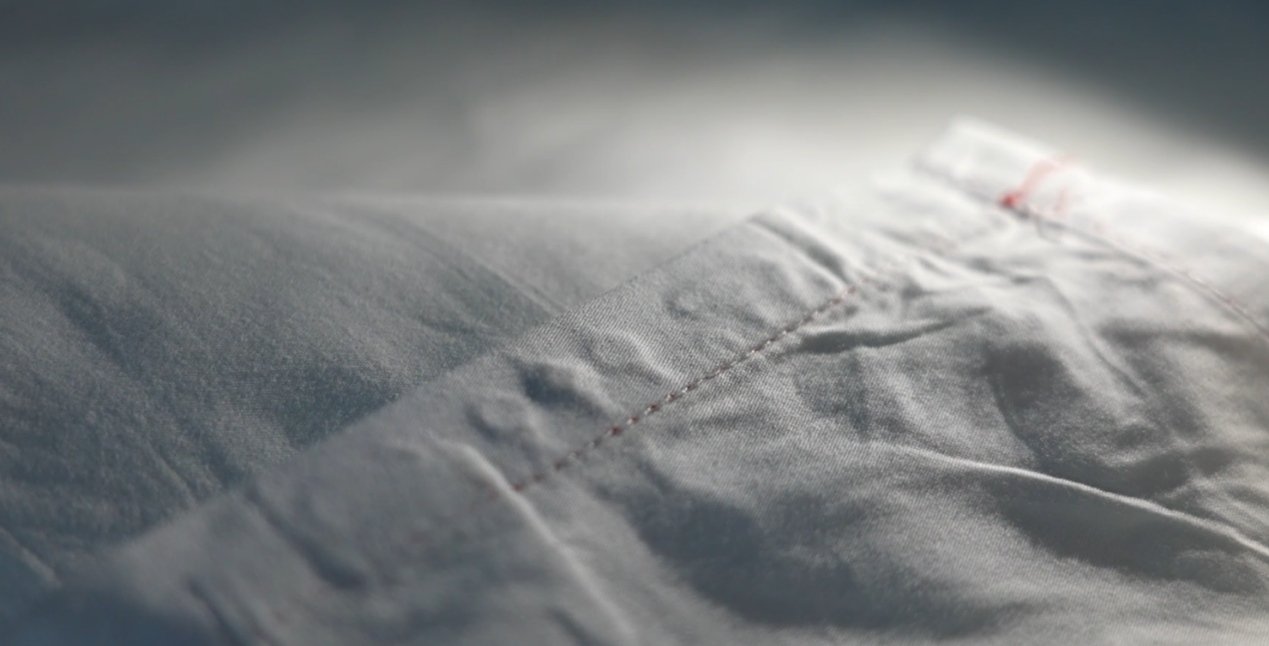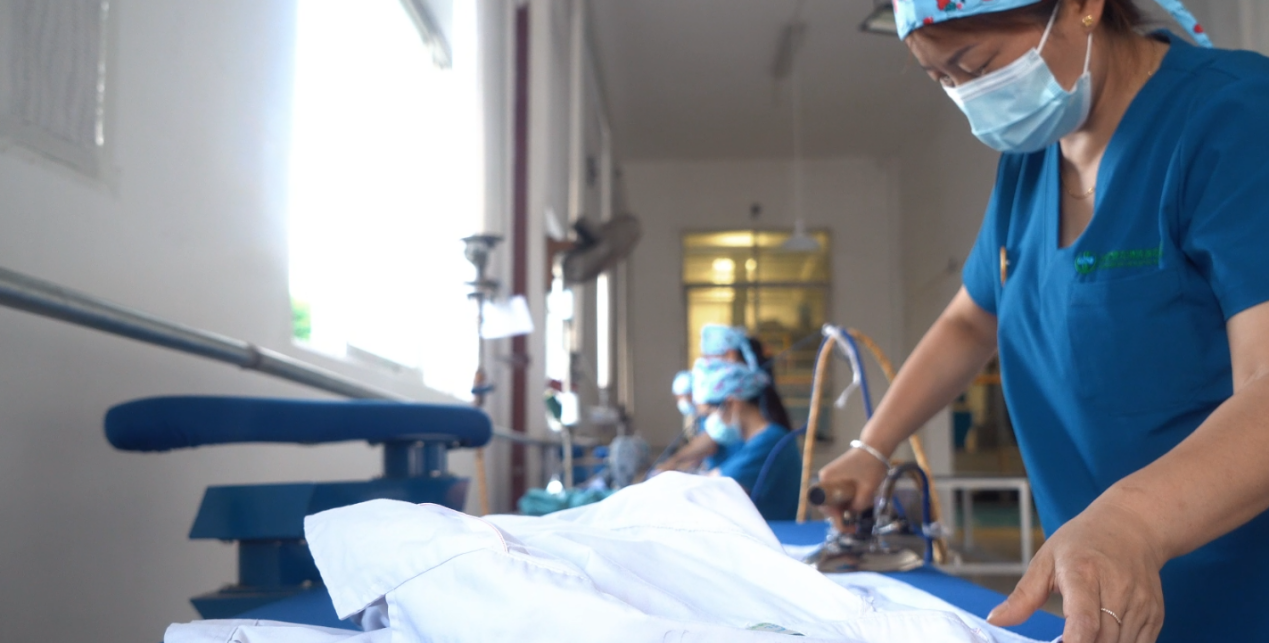In this article, we will analyze the disadvantages of the current linen management mode.
Unreasonable Layout of Laundry Room and Incomplete Zoning Functions
● The area for contaminated linen and the area for clean linen of the laundry room are completely open, without any fully enclosed partitions. Washed linen and contaminated linen are piled up in the same processing area. The contaminated linen becomes the biggest source of pollution.
● The area for contaminated linen has no dedicated collection area for dirty fabrics (no fixed counting point for dirty linen), sorting area, washing area, disinfection area, storage area for dirty carts, and buffer room for employees to change their clothes.
● There are no dedicated drying areas, ironing areas, sorting and folding areas, distribution areas, mending areas, storage areas, cleaning and vehicle storage areas, or employee changing buffer rooms, etc.
● All washing processes are done in the same space. There are no disinfection facilities, and the air, lighting, ventilation, water, pool, etc., do not meet the medical washing standards.
● There is no clear distinction between the entrance from dirty linen to the laundry room and the exit from clean linen to the laundry room. Clean linen and contaminated dirty linen share the same entry and exit channels and the same means of transportation.
Moreover, unrestricted movement of people can also lead to contamination. The entire washing process cannot achieve a transition from dirty to clean without any crossover or reverse flow, and there is a serious chance of cross-infection.
Old Laundry Equipment
● The laundry equipment is old and has been in use for too long, so that most of the circuits are aged. The employees’ operations are nonstandard. The linen in the laundry room is flammable, which poses many hidden dangers to the fire safety of hospitals.
● The laundry equipment makes loud noises. The linen after washing has much lint. The amount of waster water discharged is large. The maintenance of laundry equipment is frequent and complex. This affects the overall environment of hospitals and increases the management difficulty and costs.
● Due to the backward laundry equipment, the employees’ operations have a high degree of randomness, which causes various resources such as water, electricity, steam, and chemical materials to be wasted.
● The post-wash finishing equipment is not good. The ironing and folding of garments and linen (bedding) are inadequate, affecting the user experience.
An Unclear Process for Washing Dirty Linen
● When washing, the dirty linen before washing and the clean linen after washing are loaded and unloaded from the same loading door. The linen is operated by the same person before and after washing. This results in passive contamination.
● The linen used by medical staff, baby linen, linen on patients’ beds, linen in supply rooms and operating rooms, positive or severely contaminated linen, etc., cannot be washed separately and in separate areas. (a huge risk of cross-infection)
Incomplete Rules and Regulations of the Laundry Room
Throughout the entire washing process, there are no detailed written regulations or requirements for the collection, sorting, washing, drying, folding, ironing, mending, packaging, storage, distribution, and transportation of contaminated linen. There is no sound training system or assessment system either. It is entirely based on work experience.
This leads to the following results:
● Unreasonable washing method
The washing quality cannot be ensured. Many spots cannot be removed. The linen turns yellow and gray after long-term washing, giving a bad feeling to people.
● Arbitrary washing operation
There are no reasonable regulations on washing volume, washing temperature, washing time, amount of chemical material, chemical material usage ratio, chemical material usage procedure, and drying time control for each pot of the washing machine. This affects the service life of the linen a lot, and leads to a lot of scrapped linen.
● Inadequate assessment
During the linen arrangement process, due to inadequate assessment, many substandard products were transferred to clinical departments, resulting in low satisfaction in these departments.
Linen that should have been mended was not mended.
Linen that should have been re-processed and washed was not re-washed.
Linen that should have been scrapped was not promptly picked out and scrapped…
● Inadequate disinfection
The disinfection of the internal laundry room is not done well. There is no dedicated place or professional standard for cleaning and disinfecting various tools used (trolleys for transportation, packaging materials, plastic baskets…) This increases the probability of clean linen being recontaminated.
● Inadequate inspection
The physical indicators of clean linen (pH value should be between 6.5 and 7.5) and microbial indicators (total bacterial colony count ≤200, no detection of coliform bacteria and Staphylococcus aureus…) were not strictly sampled on a daily basis. This doesn’t meet the medical washing requirements.
Controversial Sorting and Counting of Linen
● To prevent cross-infection, the bedding is transported by the cleaning staff of each department to the laundry room for joint counting instead of being counted face to face with the nurses in the wards.
This often leads to conflicts and disputes between the laundry room and the property management workers in terms of the linen handover data.
● The departmental use of linen has increased the workload and difficulty of sorting for laundry staff.
This leads to frequent cross-distribution and confusion among clinical departments.
● On many linens, people can see the modified and hand-written names of the departments, which seriously affects the beauty of the medical linens.
A Shortage of Linen Supply in the Laundry Room
● If the laundry room is affected by some non-human factors such as water and power outages, low winter temperatures, tight steam supply, and equipment malfunctions, clinical departments often rush to complain due to the inability to turn over linen.
● When hospitals purchase medical linen on their own, they need to follow a unified procurement bidding process. As a result, they often fail to keep up with the pace of linen scrapping and renewal in time. This leads to difficulties or shortages in the turnover of clinical linen.
Uncertain Standards for Scrapping Bedding
There are no detailed scrapping standards for linen. The damaged linen was mended many times before being reported as a loss, which damaged the overall medical image.
Inpatients are also reluctant to use linen with too many patches, and as a result, clinical departments often receive complaints from patients. This brings a lot of inconvenience to the medical linen management in hospitals.
The Confusion of Different Batches of Bedding
The hospital implements a unified self-procurement process for the linen.
During the purchasing process, it is difficult to confirm the quality of the linen by sensory perception. They often choose suppliers on the basis of price. Due to changes in suppliers and different purchase batches, there is a quality variation in the purchased linen. It often becomes unusable after multiple washes due to excessive shrinkage rate or severe color fading after high-temperature washing due to poor color fastness. This causes dissatisfaction among clinical departments when using linen
Post time: Sep-18-2025



